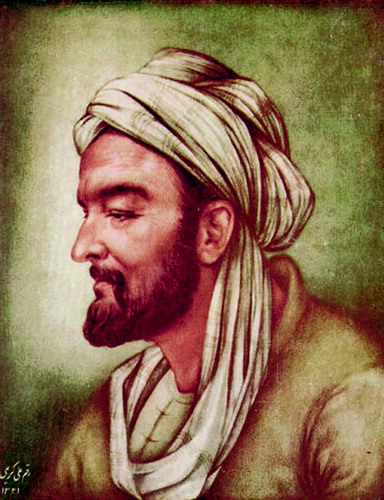Avicenna, 980–1037
How I wish I could know who I am, What it is in the world that I seek.
The Persian genius Ebne Sina, known in the West as Avicenna, who was revered as the “prince and chief of physicians” and “the second teacher after Aristotle,” wrote about 450 works, of which 240 have survived. Some of these works were written during his imprisonment due to political oppression.
Avicenna’s genius was not restricted to medicine, and he mastered many other scientific fields. For example, he invented an instrument for observing the coordinates of a star and correctly stated that the velocity of light is finite.
His Book of Healing, a vast philosophical and scientific encyclopedia (including psychology), is probably the largest of its kind ever written by one man.
His Canon of Medicine(1) is perhaps the most influential textbook ever written. Its million words were the medical Bible for 600 years thereafter in Asia and Europe. Canon of Medicine expounds on many neuropsychiatric subjects, such as sexology, lovesickness, delusion, hallucination, insomnia, nightmare, mania, melancholia, dementia, epilepsy, apoplexy, paralysis, vertigo, stroke, spasm, and tremor, and it also classifies 15 kinds of pains. This book also describes more than 760 drugs, of which 60 could be identified in the British pharmacopoeia of 1920. It deserves noting that this book not only gives various recipes for inducing both anesthesia and analgesia but also describes tracheotomy and oropharyngeal intubation (2).
Avicenna dressed in green for conducting operations and also ordered his assistants to do so.
Avicenna gave us the terms “vermis” and “tailed nucleus,” from which was derived “caudate nucleus.” He distinguished meningitis from secondary meningismus and knew about the pupil and its movements, six motor muscles for the globe, and central and peripheral types of facial weakness.
He analyzed the kernel of mind, soul, psychical streams, intellect, man’s desire, dream, and prophecy. He realized that certain physical diseases were caused by emotional upsets, and he was the first physician to stress the beneficial effect of music on emotional disturbances (1).
In describing different affective states, Avicenna developed the theory of temperaments to its fullest, and his elaborations on Galen’s temperamental types might be considered the forerunners of current personality dimensions (3).
His speculations on how diverse depressive phenomena could be understood as a mix of humors anticipated modern multiple-transmitter hypotheses of depression (3).
Avicenna was also renowned for his ingenious diagnoses and treatments. For example, he treated a severely depressed, overly inhibited woman by divulging her idol, which he identified by detecting the increase in her pulse rate when she heard his name (while her family were naming those, at Avicenna’s request, who might deserve her idolatry) (1).
From the Shiraz University of Medical Sciences. Address reprint requests to Dr. Namazi, P.O. Box 71955-687, Shiraz, Iran; [email protected] (e-mail). Image courtesy of A. Karimi.

Avicenna, 980–1037
1. Sharafkandi A: [Canon of Medicine of Avicenna.] Tehran, Iran, Sorush, 1988 (Persian)Google Scholar
2. Aziz E, Nathan B, McKeever J: Anesthetic and analgesic practices in Avicenna’s Canon of Medicine. Am J Chin Med 2000; 28:145-151Crossref, Google Scholar
3. Akiskal HS: Mood disorders introduction and overview, in Comprehensive Textbook of Psychiatry, 7th ed. Edited by Sadock BJ, Sadock VA. Baltimore, Williams & Wilkins, 2000, pp 1284-1298Google Scholar



